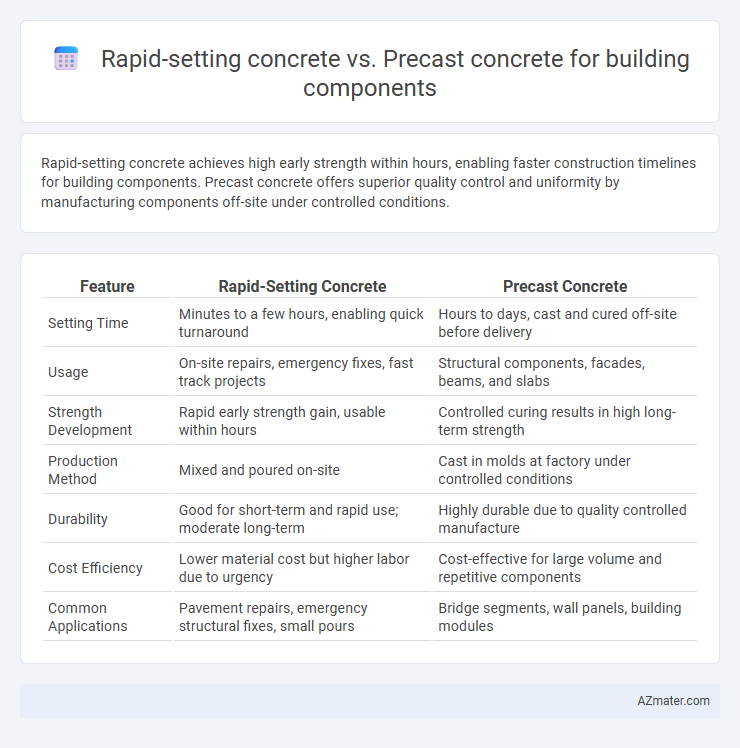Rapid-setting concrete achieves high early strength within hours, enabling faster construction timelines for building components. Precast concrete offers superior quality control and uniformity by manufacturing components off-site under controlled conditions.
Table of Comparison
| Feature | Rapid-Setting Concrete | Precast Concrete |
|---|---|---|
| Setting Time | Minutes to a few hours, enabling quick turnaround | Hours to days, cast and cured off-site before delivery |
| Usage | On-site repairs, emergency fixes, fast track projects | Structural components, facades, beams, and slabs |
| Strength Development | Rapid early strength gain, usable within hours | Controlled curing results in high long-term strength |
| Production Method | Mixed and poured on-site | Cast in molds at factory under controlled conditions |
| Durability | Good for short-term and rapid use; moderate long-term | Highly durable due to quality controlled manufacture |
| Cost Efficiency | Lower material cost but higher labor due to urgency | Cost-effective for large volume and repetitive components |
| Common Applications | Pavement repairs, emergency structural fixes, small pours | Bridge segments, wall panels, building modules |
Overview of Rapid-Setting Concrete and Precast Concrete
Rapid-setting concrete achieves high strength within hours by incorporating fast-acting cementitious materials and accelerators, making it ideal for urgent repairs and fast construction schedules. Precast concrete involves casting components in controlled factory environments, ensuring consistent quality, dimensional precision, and reduced onsite labor for building assemblies. Both methods enhance construction efficiency but differ in curing time, manufacturing process, and application scope.
Composition and Manufacturing Processes
Rapid-setting concrete is composed of high early-strength cement, accelerators, and admixtures that promote fast hydration, allowing it to achieve initial set within minutes to hours. Its manufacturing involves on-site mixing and quick placement, ideal for urgent repairs or fast-track construction. Precast concrete consists of standard or high-strength cement, aggregates, and additives, manufactured in controlled factory settings where components are cast into molds and cured under optimized conditions for uniformity and quality before transportation to the site.
Speed of Construction and Installation
Rapid-setting concrete dramatically reduces construction time by achieving initial set within 30 minutes to an hour, enabling earlier form removal and faster progress on-site. Precast concrete, manufactured off-site in controlled environments, allows simultaneous site preparation and component fabrication, facilitating quicker assembly and minimizing on-site labor. Both methods significantly accelerate project timelines, with rapid-setting concrete ideal for urgent repairs and precast concrete preferred for repetitive, large-scale production of building components.
Strength and Durability Comparisons
Rapid-setting concrete achieves high early strength within hours, enabling faster project turnover but may have slightly reduced long-term durability compared to traditional mixes. Precast concrete components, manufactured under controlled factory conditions, exhibit superior uniform strength and enhanced durability due to optimal curing and quality control. While rapid-setting concrete is advantageous for urgent repairs and time-sensitive applications, precast concrete offers consistent performance and longevity in building components subject to heavy loads and harsh environments.
Cost Implications and Budget Considerations
Rapid-setting concrete reduces project timelines by curing faster, which can significantly lower labor and equipment rental costs, making it ideal for time-sensitive budgets. Precast concrete components commonly involve higher upfront manufacturing and transportation expenses but offer consistent quality, reduced onsite labor, and minimized waste, enhancing long-term budget efficiency in large-scale projects. Comparing the total cost implications, rapid-setting concrete benefits short-term budget constraints, while precast concrete favors predictable, large-volume construction costs with potential savings in maintenance.
Flexibility in Design and Customization
Rapid-setting concrete offers superior flexibility in design and customization due to its adaptability on-site, allowing adjustments in shape, size, and finishing according to project-specific requirements. In contrast, precast concrete components are manufactured under controlled factory conditions, which provides high precision but limits real-time modification capabilities once cast. The ability of rapid-setting concrete to be molded and modified quickly makes it ideal for complex or unique architectural elements where customization is crucial.
Quality Control and Consistency
Rapid-setting concrete offers expedited curing times, enabling faster project completion but may present challenges in maintaining uniform quality across batches due to its accelerated chemical reactions. Precast concrete components are manufactured in controlled factory environments, ensuring high consistency in material composition, dimensional accuracy, and surface finish through stringent quality control protocols. This controlled production process reduces variability, often resulting in superior durability and predictable performance compared to on-site rapid-setting concrete applications.
Environmental Impact and Sustainability
Rapid-setting concrete reduces construction time and energy consumption on-site, leading to lower carbon emissions during the curing process, while precast concrete enables factory-controlled production that minimizes waste and improves material efficiency. Precast components support sustainable practices through enhanced quality control and potential reuse or recycling at the end of the building's life cycle. Combining rapid-setting concrete with precast methods can optimize environmental performance by accelerating build schedules and reducing overall resource use.
Applications in Modern Building Components
Rapid-setting concrete is ideal for fast-track construction projects, such as emergency repairs, road patches, and time-sensitive building components requiring quick load-bearing capacity. Precast concrete excels in modular building systems, including facades, structural panels, and staircases, where controlled factory conditions ensure high quality and precision. Both materials optimize construction efficiency but serve distinct roles depending on project timelines and structural demands.
Choosing the Right Solution for Your Project
Rapid-setting concrete provides accelerated strength gain, ideal for fast-track construction and emergency repairs, reducing downtime significantly in building projects. Precast concrete offers superior quality control, durability, and uniformity, making it suitable for repetitive structural components and large-scale developments. Evaluating project timelines, structural requirements, and site conditions ensures selecting the optimal solution for efficiency and long-term performance.

Infographic: Rapid-setting concrete vs Precast concrete for Building component
 azmater.com
azmater.com